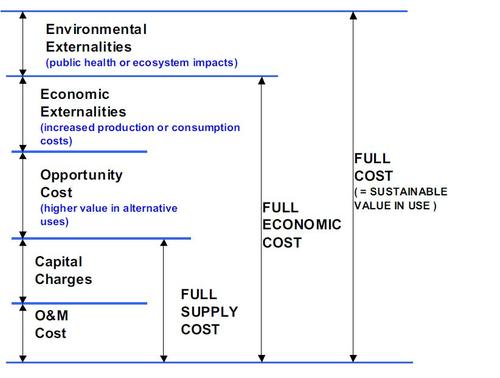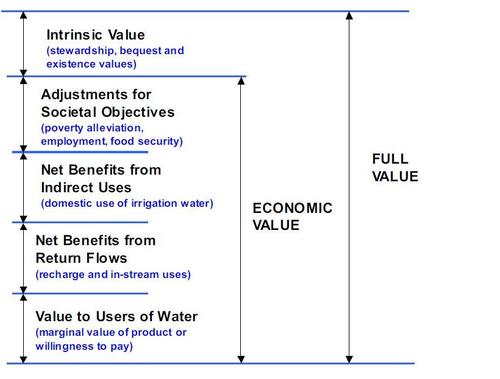Principles of water economics
There are several general principles involved in assessing the economic value of water and the costs associated with its provision. First, an understanding of the costs involved with the provision of water, both direct and indirect, is key. Second, from the use of water, one can derive a value, which can be affected by the reliability of supply, and by the quality of water. These costs and values may be determined either individually, or by analysis of the whole system. Regardless of the method of estimation, the ideal for the sustainable use of water requires that the values and the costs should balance each other. Full cost must equal the sustainable value in use.
Costs
There are three important concepts illustrated in this figure: the Full Supply Cost; the Full Economic Cost and the Full Cost:
The Full Supply Cost includes the costs associated with the supply of water to a consumer without consideration of either the externalities imposed upon others nor of the alternate uses of the water. Full Supply Costs are composed of two separate items: Operation and Maintenance (O&M) Cost, and Capital Charges, both of which should be evaluated at the full economic cost of inputs.
The Full Economic Cost of water is the sum of the Full Supply Cost as described in the previous section, the Opportunity Cost associated with the alternate use of the same water resource, and the economic externalities imposed upon others due to the consumption of water by a specific actor.
The Full Cost of consumption of water is the Full Economic Cost, given above, plus the Environmental Externalities. These costs have to be determined based upon the damages caused, where such data are available or as additional costs of treatment to return the water to its original quality.
Values
For economic equilibrium, the value of water, which we estimate from the Value in Use should just equal the full cost of water. At that point, the classical economic model indicates that social welfare is maximized. In practical cases, however, the Value in Use is typically expected to be higher than the estimated full cost. This is often because of difficulties in estimating the environmental externalities in the full cost calculations. However, in many cases it may be lower than Full Cost, Full Economic Cost, and even below Full Supply Cost. This is often because social and political goals override the economic criteria. The components of the Value in Use of water are the sum of the Economic and Intrinsic Values.
Economic Value
The value to users is at least as large as the marginal value of product. For domestic use, the willingness to pay for water represents a lower bound on its value, as there is additional value to the water. Return flow benefits from water diverted for urban, industrial, and agricultural uses constitute a vital element of many hydrological systems, thus the effects of these flows must be taken into account while estimating the value and cost of water. An example of net benefits from indirect use occurs with irrigation schemes that provide water for domestic use and livestock purposes. For water use in the household and agricultural sectors, there may be an adjustment made for societal objectives such as poverty alleviation, employment and food security.
Intrinsic Value
The concept of economic value, it should be noted, does not assign any value to concerns such as stewardship, bequest values, and pure existence values. While these are difficult to measure they are, nevertheless, valid concepts and do reflect real value associated with water use (or non-use).
(Rogers et al. 1998)

